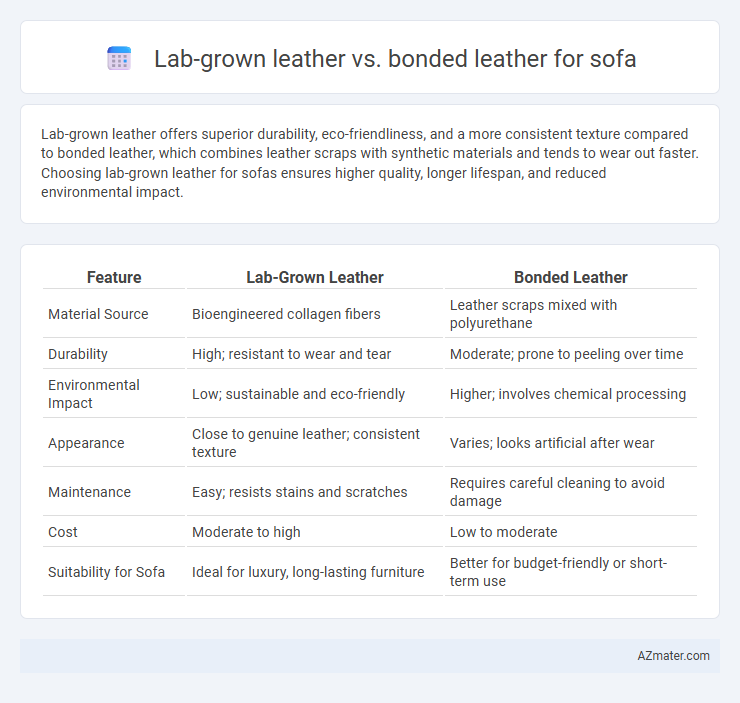Lab-grown leather offers superior durability, eco-friendliness, and a more consistent texture compared to bonded leather, which combines leather scraps with synthetic materials and tends to wear out faster. Choosing lab-grown leather for sofas ensures higher quality, longer lifespan, and reduced environmental impact.
Table of Comparison
| Feature | Lab-Grown Leather | Bonded Leather |
|---|---|---|
| Material Source | Bioengineered collagen fibers | Leather scraps mixed with polyurethane |
| Durability | High; resistant to wear and tear | Moderate; prone to peeling over time |
| Environmental Impact | Low; sustainable and eco-friendly | Higher; involves chemical processing |
| Appearance | Close to genuine leather; consistent texture | Varies; looks artificial after wear |
| Maintenance | Easy; resists stains and scratches | Requires careful cleaning to avoid damage |
| Cost | Moderate to high | Low to moderate |
| Suitability for Sofa | Ideal for luxury, long-lasting furniture | Better for budget-friendly or short-term use |
Introduction to Lab-Grown and Bonded Leather
Lab-grown leather is an innovative material produced using cultured animal cells, offering a sustainable and cruelty-free alternative to traditional leather. Bonded leather, on the other hand, is manufactured by combining shredded leather fibers with polyurethane or latex on a fabric backing, resulting in a cost-effective but less durable option. Both materials vary significantly in texture, longevity, and environmental impact, making them distinct choices for sofa upholstery.
How Lab-Grown Leather is Made
Lab-grown leather is produced through a biofabrication process that cultivates animal cells in controlled environments, enabling the creation of real leather without raising or slaughtering animals. This innovative method uses tissue engineering and cellular agriculture to grow collagen fibers, which are then assembled into durable leather sheets suitable for sofa upholstery. Unlike bonded leather, which is made from shredded leather scraps mixed with synthetic materials, lab-grown leather offers a sustainable and eco-friendly alternative with consistent quality and reduced environmental impact.
The Manufacturing Process of Bonded Leather
Bonded leather is manufactured by shredding leftover genuine leather scraps and bonding them together with a polyurethane or latex backing, creating a composite material. This process involves compressing leather fibers and applying a synthetic coating to provide durability and a uniform appearance. Unlike lab-grown leather, which is cultured from animal cells, bonded leather relies heavily on real leather waste, making it less consistent in quality and longevity.
Environmental Impact: Lab-Grown vs Bonded Leather
Lab-grown leather significantly reduces environmental impact by using fewer resources and emitting less greenhouse gas compared to traditional leather production, while bonded leather often relies on recycled leather scraps bonded with synthetic materials, which can involve chemical adhesives and limited recyclability. Lab-grown leather's sustainable process minimizes water usage and eliminates harmful tanning chemicals, making it a greener choice for eco-conscious sofa manufacturing. Bonded leather, despite utilizing waste leather, may contribute to landfill waste and pollution due to its lower durability and synthetic components.
Durability and Longevity Comparison
Lab-grown leather offers superior durability and longevity compared to bonded leather due to its consistent material composition and resistance to cracking or peeling. Bonded leather, made from leftover leather fibers combined with polyurethane or latex, tends to wear out faster and may delaminate under frequent use. For sofas, lab-grown leather provides enhanced lifespan and maintains aesthetic appeal longer, making it a more sustainable and cost-effective option over time.
Comfort and Aesthetics for Sofa Use
Lab-grown leather offers superior comfort for sofas due to its natural flexibility and breathability, closely mimicking genuine leather's texture and feel. Bonded leather, made from leather scraps bonded with polyurethane, tends to be less breathable and can feel stiffer, which may reduce overall sitting comfort over time. Aesthetically, lab-grown leather provides a more consistent and high-quality appearance with fewer imperfections, while bonded leather often shows visible wear and peeling, impacting long-term sofa appeal.
Price Differences and Affordability
Lab-grown leather generally costs more than bonded leather due to advanced manufacturing processes and sustainable materials involved, positioning it as a premium option for sofa upholstery. Bonded leather, created by combining leather scraps with polyurethane, offers a budget-friendly alternative that mimics genuine leather at a significantly lower price point. Affordability makes bonded leather popular for cost-conscious consumers, while lab-grown leather appeals to those seeking eco-friendly innovation despite higher costs.
Maintenance and Care Requirements
Lab-grown leather offers superior durability and requires minimal maintenance, needing only occasional cleaning with a damp cloth and mild soap to retain its appearance. Bonded leather, composed of leather scraps mixed with polyurethane, demands careful upkeep to prevent peeling and cracking, including avoiding excessive moisture and regular conditioning with specialized leather treatments. Choosing lab-grown leather reduces long-term care efforts and enhances resistance to wear, making it a more practical option for sofa upholstery.
Consumer Preferences and Market Trends
Lab-grown leather offers eco-friendly and durable alternatives, appealing to environmentally conscious consumers seeking sustainable sofa materials. Bonded leather remains popular for its affordability and aesthetic resemblance to genuine leather but faces criticism over durability and quality. Market trends indicate a growing shift toward lab-grown leather due to increasing demand for cruelty-free and high-performance upholstery options in sofas.
Which Leather is Best for Sofas?
Lab-grown leather offers superior durability, breathability, and eco-friendliness compared to bonded leather, making it a premium choice for sofas. Bonded leather, created by layering leather scraps with polyurethane, tends to wear and peel faster, reducing its lifespan and comfort. For sofas, lab-grown leather provides better resilience and aesthetic appeal, ensuring long-lasting quality and luxury.

Infographic: Lab-grown leather vs Bonded leather for Sofa
 azmater.com
azmater.com